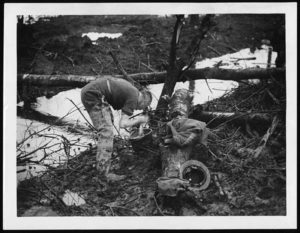Saturday March 23rd, 1918
Attacking training etc. Nice day. Had a wash in stream, stripped and washed my clothes. Also had a chat up.
Attacking Training
A simple phrase. Yet, since the start of WWI, to conduct a successful attack with lasting gains had been proved to be a costly and difficult task. This was because advances in weaponry in the decades before the War, and accelerated during it, had fundamentally changed warfare. However few understood this at the time and continued to deploy well-worn military tactics that were now irrelevant and downright dangerous.
David Zabecki identifies three paradigm shifts that impacted warfare in the early 20th Century. Battles could now be fought: on three not two dimensions (thanks to aircraft and submarine); at considerable distance rather than between lines of clashing troops (because of high-powered artillery and airborne bombing), and; at speed (with machines not marching dictating its pace). The last of these was the least developed, with armies still reliant on men and horses, and it is this lag between firepower and manoeuvre that led to the trench and static warfare that so characterized WWI.
Zabecki continues, ‘Thus, warfare between 1914 and 1918 became an extremely complicated business. Never before had so many variables, so many “moving parts” been in play at the same time. And they all had to be coordinated and synchronized. … If warfare before 1914 was like a standard chess game, warfare since World War I has been like a multi-level chess game where each player moves ten, fifteen, or even twenty pieces at the same time.’¹
As a result of all these changes, some military strategists realized that modern weapons made offensive manoeuvres almost impossible. However Generals on both sides of the conflict continued to seek to inflict the ‘knock out’ blow. Ludendorff, with his Spring Offensive, now in its third day, is the latest to act on this.
Keeping Clean

Obviously Frank enjoys bathing and washing his clothes today. Whenever it happens he calls it out in his diary, see entries here and here. This photograph is of a British soldier washing himself in a river somewhere in France.* From contemporary accounts it seems that there was quite a difference amongst the bathing habits of the Allied forces.
This presumably caused Luigi Villari to comment, ‘If at the front the British Tommy was a first-class fighting man, his discipline was equally well maintained at the base or along the lines of communication. His personal cleanliness was remarkable , and so was that of his kit and quarters.’ ²
13th (Service) Battalion War Diary – 23rd March 1918 – No 1 Sector, Olasli
The Battalion in the attack against a flagged enemy. Inter Coy Football. Night Operations (patrols)
References & Further Reading
¹ ‘Military Developments of WWI‘ by David T Zabecki from International Encyclopedia of the First World War
² ‘The Macedonian Campaign’ by Luigi Villari, published in English in 1922. Page 75
* From the papers of Field Marshall (Earl) Haig, held at the National Library of Scotland


